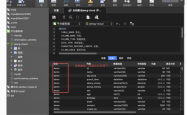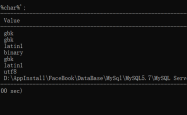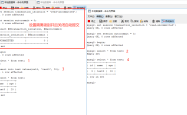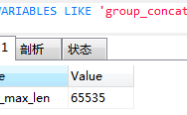一个mysql死锁场景实例分析
前言
最近遇到一个mysql在RR级别下的死锁问题,感觉有点意思,研究了一下,做个记录。
涉及知识点:共享锁、排他锁、意向锁、间隙锁、插入意向锁、锁等待队列
场景
隔离级别:Repeatable-Read
表结构如下
?| 1 2 3 4 5 6 7 8 | create table t ( id int not null primary key AUTO_INCREMENT, a int not null default 0, b varchar (10) not null default '' , c varchar (10) not null default '' , unique key uniq_a_b(a,b), unique key uniq_c(c) ); |
初始化数据
?| 1 | insert into t(a,b,c) values (1, '1' , '1' ); |
有A/B两个session,按如下顺序执行两个事务

结果是
- B执行完4之后还是一切正常
- A执行5的时候,被block
- B接着执行6,B报死锁,B回滚,A插入数据
show engine innodb status中可以看到死锁信息,这里先不贴,先解释几种锁的概念,再来理解死锁过程
共享(S)锁/互斥(X)锁
- 共享锁允许事务读取记录
- 互斥锁允许事务读写记录
这两种其实是锁的模式可以和行锁、间隙锁混搭,多个事务可以同时持有S锁,但是只有一个事务能持有X锁
意向锁
一种表锁(也是一种锁模式),表明有事务即将给对应表的记录加S或者X锁。SELECT ... LOCK IN SHARE MODE会在给记录加S锁之前先给表加IS锁,SELECT ... FOR UPDATE会在给记录加X锁之前给表加IX锁。
这是一种mysql的锁优化策略,并不是很清楚意向锁的优化点在哪里,求大佬指教
两种锁的兼容情况如下

行锁
很简单,给对应行加锁。比如update、select for update、delete等都会给涉及到的行加上行锁,防止其他事务的操作
间隙锁
在RR隔离级别下,为了防止幻读现象,除了给记录本身,还需要为记录两边的间隙加上间隙锁。
比如列a上有一个普通索引,已经有了1、5、10三条记录,select * from t where a=5 for update除了会给5这条记录加行锁,还会给间隙(1,5)和(5,10)加上间隙锁,防止其他事务插入值为5的数据造成幻读。
当a上的普通索引变成唯一索引时,不需要间隙锁,因为值唯一,select * from t where a=5 for update不可能读出两条记录来。
间隙锁相互兼容,因为如果互斥,事务A持有左半段(1,5),事务B持有右半段(1,10),那么当前面那个例子中a=5的记录被删除时,理论上左右两个间隙锁得合并成一个新锁(1,10),那么这个新的大范围锁属于谁呢?所以间隙锁相互兼容,不管是S间隙锁还是X间隙锁
插入意向锁
插入意向锁其实是一种特殊的间隙锁,从前面对间隙锁的描述中可以得知,两个事务在真正insert之前可以同时持有一段间隙的间隙锁,锁不住真正insert的这个动作。真正insert之前,mysql还会尝试获取对应记录的插入意向锁,表明有在间隙中插入一个值的意向。
插入意向锁和间隙锁互斥,比如事务1锁了(1,5)这个间隙,事务2就不能获取到a=3的插入意向锁,所以需要锁等待。
死锁过程分析
接下来就可以来分析前面那个例子中的死锁过程了,先看show engine innodb status
?| 1 2 3 4 5 6 7 8 9 10 11 12 13 14 15 16 17 18 19 20 21 22 23 24 25 26 27 28 29 30 31 32 33 34 | *** (1) TRANSACTION : TRANSACTION 5967, ACTIVE 8 sec inserting mysql tables in use 1, locked 1 LOCK WAIT 3 lock struct(s), heap size 1136, 2 row lock(s), undo log entries 1 MySQL thread id 9, OS thread handle 140528848688896, query id 537 192.168.128.1 root update insert into t(a,b) values (0, '0' ) *** (1) WAITING FOR THIS LOCK TO BE GRANTED: RECORD LOCKS space id 64 page no 4 n bits 72 index uniq_a_b of table `t2`.`t` trx id 5967 lock_mode X locks gap before rec insert intention waiting Record lock, heap no 2 PHYSICAL RECORD: n_fields 3; compact format; info bits 0 0: len 4; hex 80000001; asc ;; 1: len 1; hex 31; asc 1;; 2: len 4; hex 80000001; asc ;; *** (2) TRANSACTION : TRANSACTION 5968, ACTIVE 7 sec inserting mysql tables in use 1, locked 1 3 lock struct(s), heap size 1136, 2 row lock(s), undo log entries 1 MySQL thread id 8, OS thread handle 140528848484096, query id 538 192.168.128.1 root update insert into t(a,b) values (0, '0' ) *** (2) HOLDS THE LOCK(S): RECORD LOCKS space id 64 page no 4 n bits 72 index uniq_a_b of table `t2`.`t` trx id 5968 lock_mode X locks gap before rec Record lock, heap no 2 PHYSICAL RECORD: n_fields 3; compact format; info bits 0 0: len 4; hex 80000001; asc ;; 1: len 1; hex 31; asc 1;; 2: len 4; hex 80000001; asc ;; *** (2) WAITING FOR THIS LOCK TO BE GRANTED: RECORD LOCKS space id 64 page no 4 n bits 72 index uniq_a_b of table `t2`.`t` trx id 5968 lock_mode X locks gap before rec insert intention waiting Record lock, heap no 2 PHYSICAL RECORD: n_fields 3; compact format; info bits 0 0: len 4; hex 80000001; asc ;; 1: len 1; hex 31; asc 1;; 2: len 4; hex 80000001; asc ;; *** WE ROLL BACK TRANSACTION (2) |
session A(即TRANSACTION 5967)正在等待记录(a=1,b='1')之前的插入意向锁,session B(即TRANSACTION 5968)持有记录(a=1,b='1')之前的间隙锁,却也在等待那个插入意向锁。这说的什么玩意儿,是不是很诡异?
从头开始分析过程
- A、B分别begin,开始事务
- A先执行
select * from t where a=0 and b='0' for update;,先加了IX锁,然后原本意图为给(0, '0')这条记录加排他行锁,但是记录不存在,所以变成了排他间隙锁(-∞,1) - B再执行
select * from t where a=0 and b='0' for update;,也是先加了IX锁,因为记录不存在,所以加上了排他间隙锁(-∞,1),但是由于间隙锁相互兼容,所以没有block - A执行
insert into t(a,b) values(0,'0');,这时候,要开始真正insert了,A需要获得(0,'0')上的插入意向锁,由于和B持有的(-∞,1)排他间隙锁冲突,所以锁等待,进入记录(0,'0')的锁等待队列(虽然记录并不存在) - B执行
insert into t(a,b) values(0,'0');,要获取插入意向锁,发现虽然B自己是持有(-∞,1)的排他间隙锁,但是A也有,所以进入等待队列,等待A释放 - 叮,死锁发生
死锁信息解读
事务1(TRANSACTION 5967),等待获得锁index uniq_a_b of table t2.t trx id 5967 lock_mode X locks gap before rec insert intention waiting,即在唯一索引uniq_a_b上的插入意向锁(lock_mode X locks gap before rec insert intention)
锁的边界为
| 1 2 3 | 0: len 4; hex 80000001; asc ;; 1: len 1; hex 31; asc 1;; 2: len 4; hex 80000001; asc ;; |
表明两行记录
- 0和1表示uniq_a_b上的值,a=1,b=0x31(即'1'的ascii码)
- a=1,b='1'对应的主键id=1,因为innodb的索引结构决定的,二级索引(非主键索引)指向主键索引,主键索引再指向数据,所以需要给主键加索引
至于int值按位或上的0x80000000就不是很清楚为什么了,需要大佬解读
事务2(TRANSACTION 5968),持有间隙锁index uniq_a_b of table t2.t trx id 5968 lock_mode X locks gap before rec,等待插入意向锁index uniq_a_b of table t2.t trx id 5968 lock_mode X locks gap before rec insert intention,所以死锁发生。
原则上是innodb引擎判断哪个事务回滚代价小就回滚哪个事务,但是具体评判标准不是很清楚(再一次需要大佬),这里innodb选择了回滚事务2。至此,死锁过程分析完毕
One More Thing
还没完。。。有个神奇的现象是,如果表结构变成
?| 1 2 3 4 5 6 7 8 9 | create table t ( id int not null primary key AUTO_INCREMENT, a int not null default 0, b varchar (10) not null default '' , c varchar (10) not null default '' , unique key uniq_c(c), unique key uniq_a_b(a,b) ); insert into t(a,b,c) values (1,1,1); |
只是把c上的唯一索引uniq_c放到了uniq_a_b前面,那么最后的死锁信息就变了!
?| 1 2 3 4 5 6 7 8 9 10 11 12 13 14 15 16 17 18 19 20 21 22 23 24 25 26 27 28 29 30 31 32 33 | *** (1) TRANSACTION : TRANSACTION 5801, ACTIVE 5 sec inserting mysql tables in use 1, locked 1 LOCK WAIT 4 lock struct(s), heap size 1136, 3 row lock(s), undo log entries 1 MySQL thread id 5, OS thread handle 140528848688896, query id 380 192.168.128.1 root update insert into t2(a,b) values (0, '0' ) *** (1) WAITING FOR THIS LOCK TO BE GRANTED: RECORD LOCKS space id 56 page no 5 n bits 72 index uniq_a_b of table `t2`.`t2` trx id 5801 lock_mode X locks gap before rec insert intention waiting Record lock, heap no 2 PHYSICAL RECORD: n_fields 3; compact format; info bits 0 0: len 4; hex 80000001; asc ;; 1: len 1; hex 31; asc 1;; 2: len 4; hex 80000001; asc ;; *** (2) TRANSACTION : TRANSACTION 5802, ACTIVE 4 sec inserting mysql tables in use 1, locked 1 3 lock struct(s), heap size 1136, 2 row lock(s), undo log entries 1 MySQL thread id 6, OS thread handle 140528848484096, query id 381 192.168.128.1 root update insert into t2(a,b) values (0, '0' ) *** (2) HOLDS THE LOCK(S): RECORD LOCKS space id 56 page no 5 n bits 72 index uniq_a_b of table `t2`.`t2` trx id 5802 lock_mode X locks gap before rec Record lock, heap no 2 PHYSICAL RECORD: n_fields 3; compact format; info bits 0 0: len 4; hex 80000001; asc ;; 1: len 1; hex 31; asc 1;; 2: len 4; hex 80000001; asc ;; *** (2) WAITING FOR THIS LOCK TO BE GRANTED: RECORD LOCKS space id 56 page no 4 n bits 72 index uniq_c of table `t2`.`t2` trx id 5802 lock mode S waiting Record lock, heap no 3 PHYSICAL RECORD: n_fields 2; compact format; info bits 0 0: len 0; hex ; asc ;; 1: len 4; hex 80000002; asc ;; *** WE ROLL BACK TRANSACTION (2) |
事务2等待的锁由前面的插入意向锁变成了共享锁。什么鬼?
由于没看过源码,只能根据现象倒推:因为表结构上c的唯一索引在(a,b)前面,而插入的时候没指定c的值,用的默认值0,innodb需要先去查一下有没有0这条记录,有的话就要报唯一键冲突了,所以先要加S锁,但是在(0,'0')这条记录上已经有了IX锁,看一下前面的兼容性矩阵,S锁和IX锁互斥,所以也只能锁等待
总结
看似一句简单的select和insert,底下设计非常复杂的锁机制,理解这些锁机制有利于写出高效的SQL(至少是正确的
1.本站遵循行业规范,任何转载的稿件都会明确标注作者和来源;2.本站的原创文章,请转载时务必注明文章作者和来源,不尊重原创的行为我们将追究责任;3.作者投稿可能会经我们编辑修改或补充。










